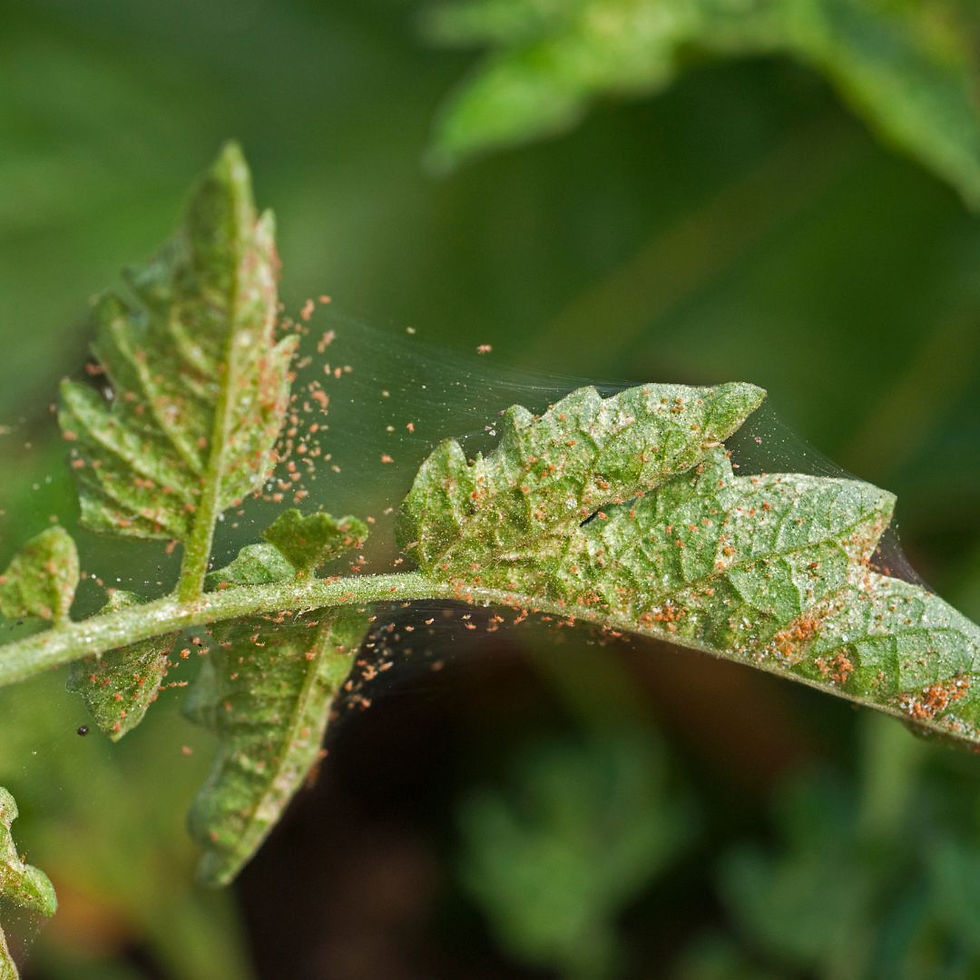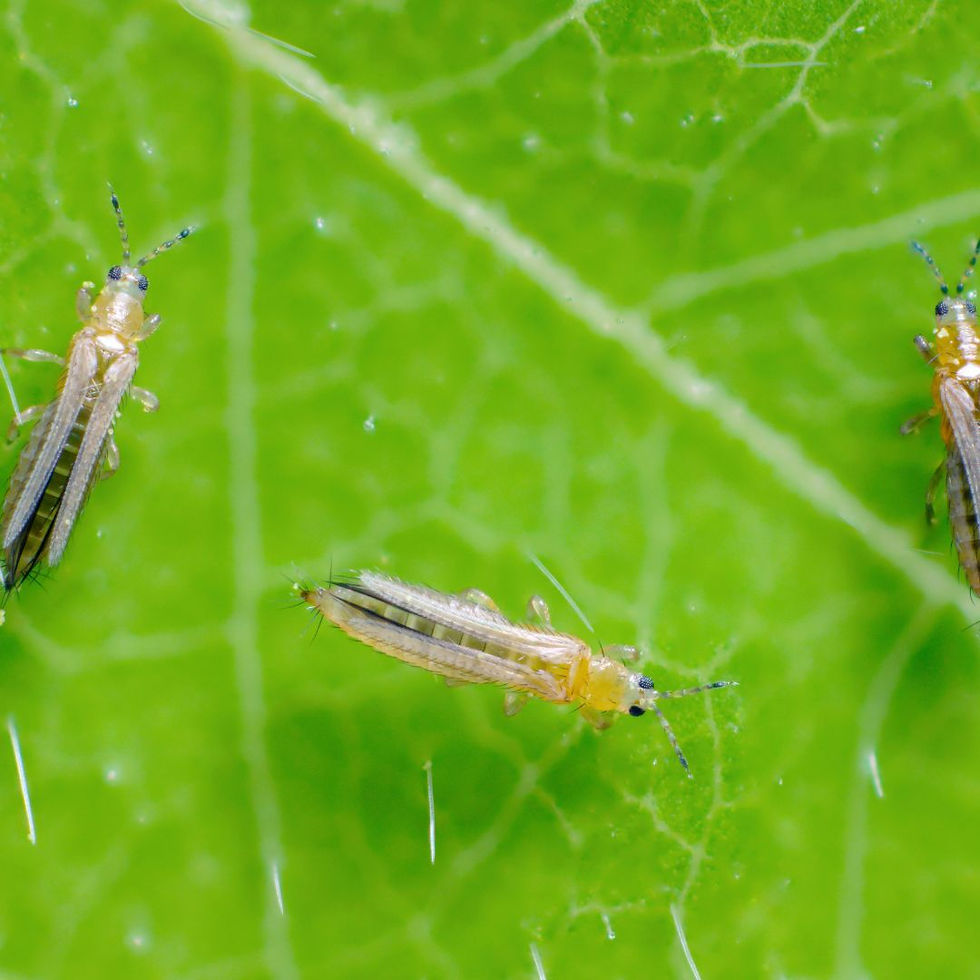Get to Know the 10 Most Common Garden Pests
- Millawanda Urban Farming
- Jul 31
- 4 min read
Pest control is a common issue for those who grow plants in their homes, on balconies, and in gardens. Environmental conditions and common mistakes in plant care and watering can also invite pests. To avoid losing the plants we've labored over to insects and pests, it's crucial to know how to identify and treat common pests, or prevent them in the first place.
In this article, we've compiled the 10 most common garden pests, how to identify their damage, and natural solutions you can use to protect your garden without using harmful chemicals.
Aphids
Aphids suck the plant's sap, weakening growth and attracting mold and ants.
Over-fertilizing, especially nitrogen-rich fertilizer, can cause aphids. Crowded plants or lack of airflow can also be a contributing factor.
Diagnosis:
Small, soft-bodied insects appear in clusters of green, black, white, yellow, or pink.
They are found on the undersides of leaves and around emerging shoots.
Leaves may curl, wilt, or appear sticky (honeydew).
Ants may be present to prey on aphids.

Treatment:
Quarantine the plant.
Spray with neem oil or a soapy water solution.
Prune heavily infested stems.
In the greenhouse, use ladybugs or lacewings to eat the aphids.
Fungus Gnats (Indoor and Seedling Killer)
Fungus gnats are a problem we can see in every home and on every plant. They thrive in constantly damp, overwatered, or poorly drained soil. Decayed but unpruned plant debris or old mulch in or around the pot can also be a cause.
The larvae feed on roots and are particularly dangerous for seedlings.
Diagnosis:
Small black flies hovering on the soil or near windows.
Larvae seen in damp soil, especially on potted plants.
Wilding, stunted seedlings, or yellowing leaves.

Treatment:
Allow the soil to dry completely between waterings.
Sprinkle cinnamon on the soil surface.
Set up yellow sticky traps.
Apply Bacillus thuringiensis (Bt): Bt is a sporulating, gram-positive soil bacterium that is toxic to the larvae of many agricultural and forestry pests.
Spider Mites
Spider mites suck chlorophyll, drying out the plant. They prefer extremely dry and dusty environments and are often seen indoors.
Diagnosis:
Fine, silky webs on the undersides of leaves or stems
Leaves become mottled, bronze, dry, and curled
Close inspection reveals small red or yellow dots (mites)

Treatment:
Increase humidity by misting regularly. Spider mites cannot survive in humid environments.
Rinse leaves thoroughly with water.
Apply neem oil or a detergent solution every 3-5 days.
Isolate infested plants indoors.
Mealybugs
Indoor plants are often affected by overwatering and hot, stagnant air. Weak plants are more susceptible to attracting mealybugs. Furthermore, lack of regular cleaning and pruning can lead to mealybugs.
Mealybugs suck plant sap, causing stress and fungal problems.
Diagnosis:
White, hairy, or waxy clumps at leaf joints and stems
Leaves may turn yellow, curl, or the plant may stop growing
Sticky honeydew residue may appear

Treatment:
You can pick off mealybugs with a cotton swab dipped in pure alcohol.
You can spray with neem oil or a soapy solution.
You can prune heavily infested areas.
Whiteflies
Whiteflies aren't actually flies, but belong to the Aleyrodidae family. They can be found in warm, humid environments, especially greenhouses and indoor spaces. They favor lush, leafy, and heavily fertilized plants. Inadequate air circulation can also contribute to these flies.
Diagnosis:
Small white insects fly when the plant is moved.
Leaves may turn yellow or appear burnt.
Sticky residue and black sooty mold may be present.

Treatment:
Use yellow sticky traps
Spray with neem oil or garlic spray
Use natural predators such as Encarsia formosa or ladybugs in the greenhouse
Slugs and Snails
Snails, the arch-enemy of our gardens, love leafy greens like lettuce and spinach, as well as the green leaves of flowers like tulips and lilies. We often see them crawling across our greenery like zombies after rain.
They prefer cool, moist environments and overwatered gardens. Another common culprit is decaying organic waste in the garden.
Some gardeners throw harvested leaves like lettuce and cabbage near the plants, attracting the snails to these wastes. Applying beer is also a common solution. However, if you don't want to kill them, you should hand-pick them one by one in the morning or evening.
Diagnosis:
Shiny, slimy marks on the soil or leaves
Irregular holes in leaves or chewed stems
Damage occurs at night or in the early morning

Treatment:
Hand-collect them in the morning or evening.
Use beer traps (place a bowl of beer in the garden), crushed eggshells (think of them as broken glass to deter them from approaching the plant), or copper tape.
Caterpillars and Cabbage Worms
Butterfly moths lay their eggs on the undersides of plant leaves during warm weather. They can be seen in gardens with a high concentration of cruciferous crops. They cause large holes in the leaves, especially in vegetables like cabbage and kale.
Diagnosis:
Green caterpillars or black dot-like droppings on the undersides of leaves
Leaves with gnawed skeletons

Treatment:
Protect the plant during moth season or apply Bacillus thuringiensis (Bacillus thuringiensis).
Check the backs of leaves in the morning, pick them by hand, and destroy them.
Spray with a solution of thyme oil and peppermint oil.
Thrips
Thrips cause silvery or striped spots on the plant's leaves. Small black dots (spills) and twisted growth may be observed.

Neem oil solution is perfect for this problem too.
Scalebugs
They appear as hard, small spots that nestle in branches and leaves. They cause yellowing of the plant's leaves or stunted growth.
You can remove them with a toothbrush or alcohol swab.
Leafworms
Leafworms, or miners, bore into the plant's leaves, disrupting photosynthesis. You may notice hollow white paths or drained leaves on the plant's leaves. They are most common in vegetables like spinach, chard, and beets. You can apply neem oil regularly to prevent egg laying.

Natural Insecticide You Can Make at Home
Garlic Spray: Garlic, water, soap
Pepper Spray: Hot peppers soaked in water for a day
Neem Spray: Recipe here.
To prevent pests from spreading, it's crucial to prevent rot around your plants, avoid overcrowding, and regularly inspect the undersides of leaves. Early detection saves lives!



Comments